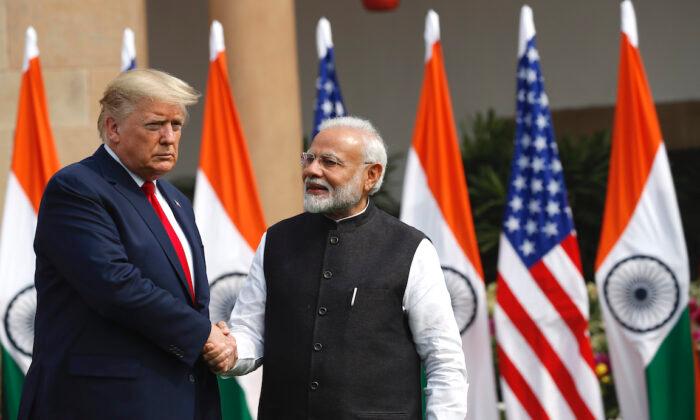China’s plans to divert two trans-Himalayan rivers that sustain millions in downstream regions in India, Pakistan, and Bangladesh are adding to India’s burgeoning concerns, experts say, at a time when tensions along the China–India border continue to simmer.
The experts say India should establish an “international multilateral framework” to deal with China’s plans, which include a project that one Chinese geotechnical engineer says would “turn Xinjiang into California.”
At issue are two mighty rivers, the Brahmaputra and the Indus, which originate in Tibet. The Indus runs through northwestern India into Pakistan, while the Brahmaputra flows through northeastern India into Bangladesh. Both are among the longest and largest rivers in the world.
India is named after the Indus, and the word Hindu comes from it; the river is sacred to India’s Hindus and central to the development of India’s civilization.
For many years, China has planned to divert the Brahmaputra, called the Yarlung Zangbo in Tibet, and the Indus from their place of origin to the arid regions in China’s Xinjiang Autonomous Region. Both of the rivers flow from the Tibetan plateau into two Indian states that share border disputes with China.
The Indus flows in the federally governed state of Ladakh, which has since May been the flashpoint of the conflict with China. The Yarlung Zangbo flows into Arunachal Pradesh, an Indian state that also shares a border with Bhutan and that China claims as its territory.
“The current project proposes diverting water from southern Tibet’s Yarlung Tsangpo by drilling a 1,000-km tunnel across the world’s ’third pole‘ or ’Asia’s water tower,' permafrost-melting, glacier-shrinking Tibetan plateau to the arid Taklamakan [a desert in southwest Xinjiang],” Dr. Burzine Waghmar, of the SOAS South Asia Institute in London, told The Epoch Times in an email.
The plan to deviate Yarlung Zangbo from Tibet to Xinjiang was first devised by the Qing dynasty in the 19th century, but the project’s enormous cost and engineering challenges, as well as the river’s international status, meant that the project never took off, Waghmar said.
In recent years, he said, the Chinese administration has been trying to revive the project and a trial run is currently occurring in Yunnan Province, where tunnels are being drilled with engineering techniques, technology, and equipment that will be later replicated in Xinjiang. Construction on a 373-mile (600 kilometers) Yunnan tunnel started in August 2017.
“It is to show we have the brains, muscle, and tools to build super-long tunnels in hazardous terrains, and the cost does not break the bank,” Chuanqing said about the $11.7 billion (78 billion yuan) project.
“The ‘researchers’ propose to add a South Western segment to the Western Diversion Route (not yet started), which is the third part of the South-to-North Water Diversion Project,” said Arpi, quoting various Chinese sources. “It would involve the diversion of the waters from the Indus river in Western Tibet (before it enters Ladakh) towards the Tarim Basin in Xinjiang.

Plan Would Create World’s Longest Tunnel
China’s plan to divert the Yarlung Zangbo consists of building the world’s longest tunnel, a 621-mile (1,000 kilometers) proposal that would steer water from the high Tibetan plateau to Xinjiang and involve multiple sections and waterfalls—a project that a Chinesel engineer said would “turn Xinjiang into California,” according to a paper by Naseer Ahmed Abbasi and Xiangzhou Xu published in the 22nd European Geosciences Union General Assembly in May.As development in China shifts to untapped high-altitude and rough terrain or arid regions in Tibet and Xinjiang from the saturated cities in the east, river diversion and hydroelectric projects are integrated with China’s economic as well as strategic development, Dr. Satoru Nagao, a visiting fellow at the Washington-based Hudson Institute, told The Epoch Times in an email.
“Therefore, for the Chinese government, development on the western side is vital for the eastern side. That is the reason if China wants to develop Xinjiang Uygur, China needs to find water in Xinjiang Uygur. If there is not enough water, China needs to bring water from Tibet,” he said, adding that these projects are essential for China’s agricultural and mineral resource development as well.
The Tibet-Xinjiang diversion project that requires 1 billion yuan (approximately $147.3 million) per kilometer of tunnel would bring 10–15 billion tonnes of water every year. The project is “anticipated to solve the problem of water, food, and drought in the country,” say Abbasi and Xu, of the School of Hydraulic Engineering at the Dalian University of Technology in China.

Why India Should Worry
Diverting the Yarlung Tsangpo is expected to occur in Sangri County near the disputed Indian border, Waghmar said. He noted that no water treaties exist between China and India or Bangladesh where the river eventually joins the Bay of Bengal.On June 15, a violent clash took place in Galwan in the Ladakh territory; 20 Indian soldiers and an unknown number of Chinese soldiers died. Since then the two sides have jockeyed for strategic position and massively built up their forces in the area.
“As the recent clashes on the Sino-Indian border have made clear, India needs to assess how China might ‘weaponize’ its advantage over those countries downstream,” Singh and Tembey said. “Control over these rivers effectively gives China a chokehold on India’s economy.”
Nagao says the river diversion project is strategically relevant, and India should be concerned, in the wake of the Galwan incident. He said if China diverts the rivers in these sensitive areas, it will deploy the military to protect the project, and any military build-up would cause more concerns for India.
“This nightmare scenario has already started. Because China needs more water to develop, China has started plans to divert the flow of the river,” Nagao said. “The more China develops Tibet, the more Chinese troops will get deployed to secure these water resources. As a result, China’s military activities in the India-China border (around Tibet) will increase.”
He pointed out that the current conflict started in response to China’s infrastructure deployment on the border. India responded by starting construction on a road, which became the cause of the current stalemate.
“India has tried to catch up by deploying forces and building infrastructure. Finally, China tried to prevent India to develop roads, they intentionally entered the Indian side and clashed in Galwan,” he said.
Waghmar said diverting waters from the Yarlung Tsangpo, which shares its source with the Indus, will also adversely affect Pakistan as it flows through Gilgit-Baltistan into that nation’s breadbasket region, Punjab.
Nagao said India’s response to the river diversion project should be twofold. To prevent Chinese incursions on the border, India should strengthen its defense capabilities and should step up coordination with the United States, Japan, and Australia.
“To assure water resources, India should establish an international multilateral framework to decide the share of water resources,” said Nagao, adding that a bilateral framework to share water with China wouldn’t be effective.
“In this case, India should invite the U.S., Japan, and Australia to counter power balance in the framework if possible,” he said.





